| کد مقاله | کد نشریه | سال انتشار | مقاله انگلیسی | نسخه تمام متن |
|---|---|---|---|---|
| 2576864 | 1561361 | 2006 | 11 صفحه PDF | دانلود رایگان |

Could certain disorders, such as schizophrenia, be evolutionary correlates of Homo sapiens' creative mind? Both Timothy Crow and David Horrobin gave affirmative answers. Natural selection should have eliminated any genetic tendency to suffer from mental illnesses. Since this is not the case, some adaptive advantages must be associated with schizophrenia. The advantage might be related with language, religion, creativity or certain personality traits fixed at the latest stages of our evolutionary journey. Though no susceptibility genes for schizophrenia have been identified thus far, neuropsychological tests and neuroimaging techniques have revealed that in schizophrenic patients the most affected frontal brain area seems to be the dorsolateral prefrontal cortex (DLPFC). The DLPFC is one of the areas in which DTNBP1, a suspected “schizophrenia gene”, is expressed. Our research team also found DLPFC activation in healthy participants while performing an aesthetic judgment task, thus relating a “creativity” task with that area. Our research is currently focused on brain activation patterns of schizophrenic patients while carrying out the same aesthetic judgment task, aiming to assess the potential role of DLPFC as a neurological link between mental illness and artistry.
Resumen¿Pueden ciertas patologías, como la esquizofrenia, ser consecuencias evolutivas de la mente creativa de los Homo sapiens? Tanto Timothy Crow como David Horrobin han dado respuestas afirmativas. La selección natural debería haber eliminado cualquier tendencia genética a sufrir de enfermedades mentales. Puesto que éste no es el caso, deben existir ventajas adaptativas asociadas a la esquizofrenia. La ventaja podría estar relacionada con el lenguaje, la religión, la creatividad o ciertos rasgos de la personalidad fijados en las últimas etapas de nuestro viaje evolutivo. Aunque hasta el momento no se han identificado genes de susceptibilidad para la esquizofrenia, las pruebas neuropsicológicas y las técnicas de neuroimagen han revelado que el área frontal del cerebro más afectada en pacientes esquizofrénicos parece ser la corteza prefrontal dorsolateral (DLPFC). La DLPFC es una de las áreas en las cuales se expresa DTNBP1, sospechoso de ser un “gen de la esquizofrenia”. Nuestro equipo de investigación también ha encontrado activación de la DLPFC en participantes sanos que realizaban una prueba de juicio estético, relacionando así una tarea de “creatividad” con esa área. Nuestra investigación se centra actualmente en los patrones de activación cerebral en pacientes esquizofrénicos que realizan la misma prueba de juicio estético, intentando determinar el papel potencial de la DLPFC como vínculo neurológico entre la enfermedad mental y el arte.
Journal: International Congress Series - Volume 1296, June 2006, Pages 95–105